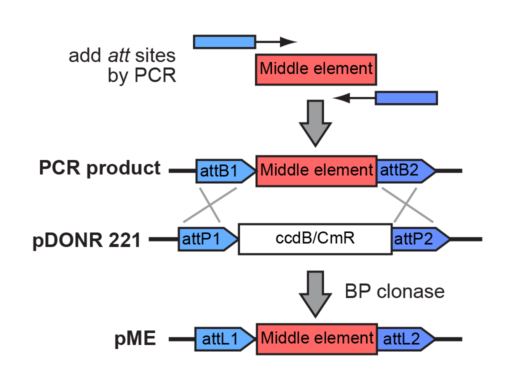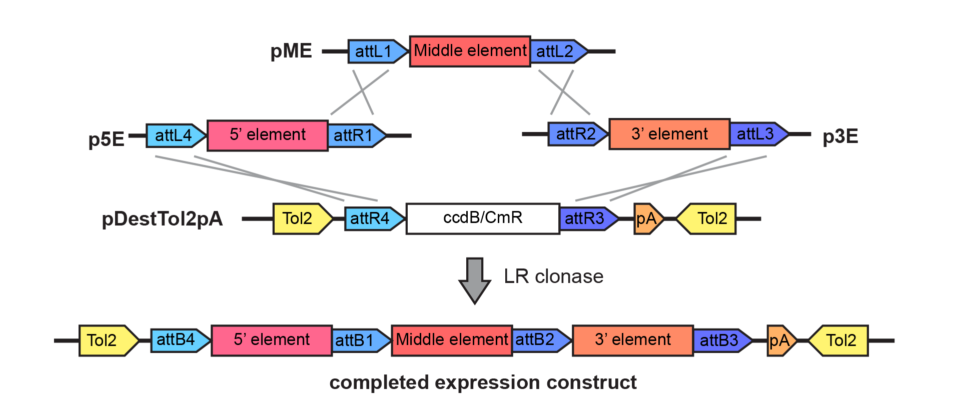(→Principles of Gateway recombination) |
(→How we use this in the Tol2kit) |
||
| Line 12: | Line 12: | ||
== How we use this in the Tol2kit == | == How we use this in the Tol2kit == | ||
| + | |||
| + | To generate zebrafish expression constructs, we generally place enhancer-promoter constructs in the 5' (p5E) clones, reporters or genes of interest in the middle (pME) clones, and polyadenylation signals, C-terminal fusion tags, or IRES tags in the 3' (p3E) clones. Of course there are other possibilities as well, e.g. putting an N-terminal fusion tag in the middle clone and then a gene of interest in the 3' clone. | ||
| + | |||
| + | The destination clone bears transposon ends (Tol2 terminal inverted repeats), a polyadenylation signal (in case no polyA signal is included in the 3' clone), and sometimes a transgenesis marker like ''cmlc2'':egfp-polyA. | ||
| + | |||
| + | Given the different clones in this toolkit, one can thus add a great deal of functionality to an expression clone by assembling it using a multisite Gateway reaction. For instance, by using p5E-bactin2, pME-nlsmCherry, p3E-IRES-EGFPCAAX-pA, and pDestTol2CG2, a single Gateway reaction can yield the construct ''bactin2'':nlsmCherry-IRES-EGFPCAAX-pA; ''cmlc2'':egfp-pA, which will express nuclear mCherry and membrane-localized EGFP ubiquitously, along with cytoplasmic EGFP in the heart as a transgenesis marker. | ||
| + | |||
| + | In the future, we are planning to build new destination vectors to use other transposons, e.g. Sleeping Beauty, and to add other desired elements such as insulators. | ||
Revision as of 13:07, 11 September 2007
(under construction. 1/31/07)
Principles of Gateway recombination
Here's a diagram of a Gateway BP reaction, showing an example of how a "middle" clone (pME) is constructed using PCR with gene-specific primers to add att sites, then recombination with a donor vector.
Here's a diagram of a multisite Gateway LR reaction, combining three entry clones (p5E, pME, p3E) with the destination vector pDestTol2pA.
How we use this in the Tol2kit
To generate zebrafish expression constructs, we generally place enhancer-promoter constructs in the 5' (p5E) clones, reporters or genes of interest in the middle (pME) clones, and polyadenylation signals, C-terminal fusion tags, or IRES tags in the 3' (p3E) clones. Of course there are other possibilities as well, e.g. putting an N-terminal fusion tag in the middle clone and then a gene of interest in the 3' clone.
The destination clone bears transposon ends (Tol2 terminal inverted repeats), a polyadenylation signal (in case no polyA signal is included in the 3' clone), and sometimes a transgenesis marker like cmlc2:egfp-polyA.
Given the different clones in this toolkit, one can thus add a great deal of functionality to an expression clone by assembling it using a multisite Gateway reaction. For instance, by using p5E-bactin2, pME-nlsmCherry, p3E-IRES-EGFPCAAX-pA, and pDestTol2CG2, a single Gateway reaction can yield the construct bactin2:nlsmCherry-IRES-EGFPCAAX-pA; cmlc2:egfp-pA, which will express nuclear mCherry and membrane-localized EGFP ubiquitously, along with cytoplasmic EGFP in the heart as a transgenesis marker.
In the future, we are planning to build new destination vectors to use other transposons, e.g. Sleeping Beauty, and to add other desired elements such as insulators.

